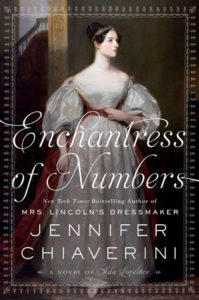Book Review: Enchantress of Numbers by Jennifer Chiaverini
Augusta Ada King-Noel, Countess of Lovelace (1815-1852) is better known to us today as Ada Lovelace. Her primary claim to fame is her “notes” on Charles Babbage’s Analytical Engine, which anticipated uses for this theoretical calculating device far beyond mere number-crunching, and provide the first known published algorithm for programming such a device. And hence, she is considered by some to be the first computer programmer (or at least a honored predecessor of same.)
This novel is a fictionalized biography of Ada, inventing conversations, smoothing out inconsistencies in the source material (fortunately, many of Ada’s letters and those of her relatives survive) and at least one name change for convenience.
During her lifetime, Ada was an involuntary celebrity due to being the only child of George Gordon, Lord Byron’s marriage. A lengthy prologue to the main story tells of Anne Isabella Milbank’s falling in love with the brilliant poet. Unfortunately for everyone involved, this Regency romance did not end his multiple affairs with both other women and men, and possibly his half-sister Augusta Leigh. (For the purposes of this novel, that relationship is treated as real.)
Soon after Ada was born, Lady Byron decided she could no longer take her husband’s treatment of her, and fled with the child. Because of the massive scandal involved with their separation and the many rumors (some true, some scurrilous) about his behavior, Lord Byron left England for the rest of his life.
Lady Byron (who comes off as kind of a prig in this book) decided that although she’d been unable to fix her husband’s bad behavior (which she put down to insanity in the blood), she could raise her daughter to be rational. To that end, Ada’s tutoring emphasized mathematics and science, while poetry and other things that might inflame the imagination were forbidden. Whereupon young Ada’s imagination simply manifested itself in thoughts about math and science.
The feeling that really comes across from this book is frustration due to lost potential. Young Ada is sheltered to keep away the 19th Century equivalent of paparazzi and toxic fans of her father, plus frequent illnesses. So she winds up with few friends and some severe naivete about relationships that bites her when she falls in love with a tutor. In her early teens, Ada developed an interest in heavier-than-air flight, and made some proportionately impressive progress before her mother decided this was a “mania” and forbade her to pursue the subject.
As she neared adulthood, Ada was required to become a debutante and become part of Society, looking for a suitable husband. This did, however, finally allow her to connect with other people interested in math and science, including Charles Babbage, who was touting his Difference Engine. (The Difference Engine would have been an early type of calculator; the more advanced Analytical Engine would have become an actual primitive computer.)
Ada and Babbage became friends due to her fascination with the prototype Engine he’d created. Sadly, the government funding for the fully-functional version had been stalled, with not even the initial installment being fully paid. Worse, Babbage’s temper got the best of him when trying to deal with government officials, making them not want to help him out.
Ada got married to William King-Noel, a respectable nobleman who was elevated to the rank of Earl of Lovelace, making Ada a countess. Much of her time was taken up being a mother to their three children, but eventually the aid of governesses allowed her more leisure to pursue education and research. But uterine cancer laid her low at age 36 before she made much headway.
As the “exciting” bits of Ada’s life are relatively few and far-between, much of the book is taken up with blow-by-blow accounts of long periods of toddlerhood and adolescence where not much happens at great length. The strained relationship between Ada and her mother (and her mother’s coterie of like-minded spinsters) occupies a large part of the book.
Readers who are most interested in the math and science part of Ada Lovelace’s life might be better served by reading steampunk fiction where she appears as those speculative stories allow her potential to be more fully realized. This book is recommended more for the “literary biography” crowd.
And now, let’s have a different look at the Countess’ influence:


1 comment
Comments are closed.